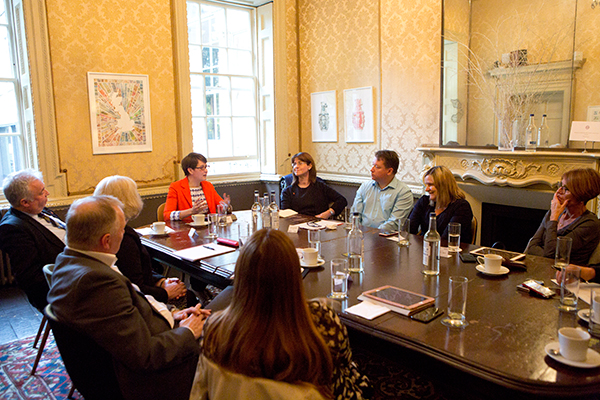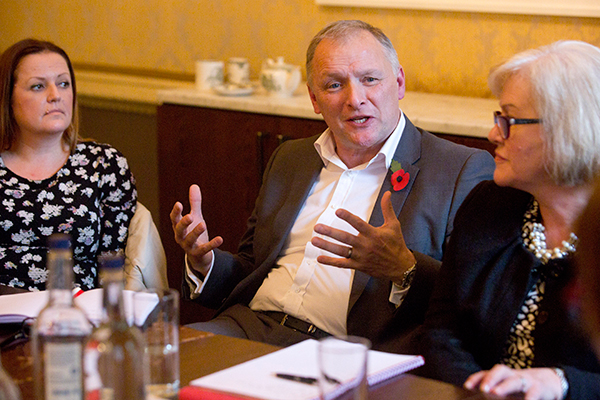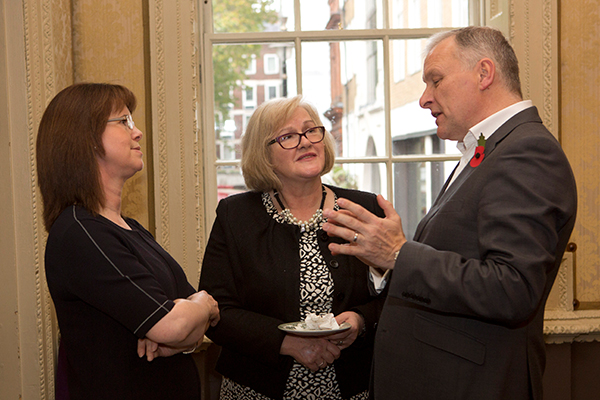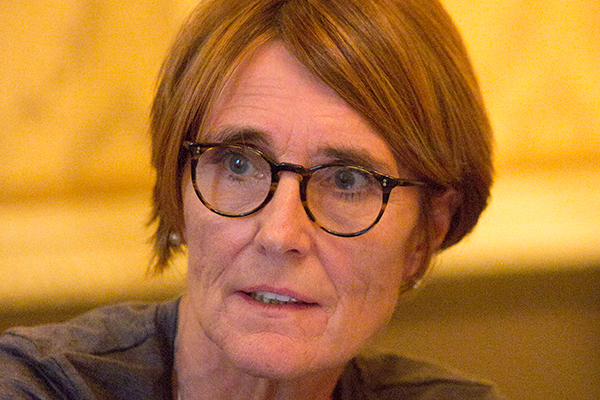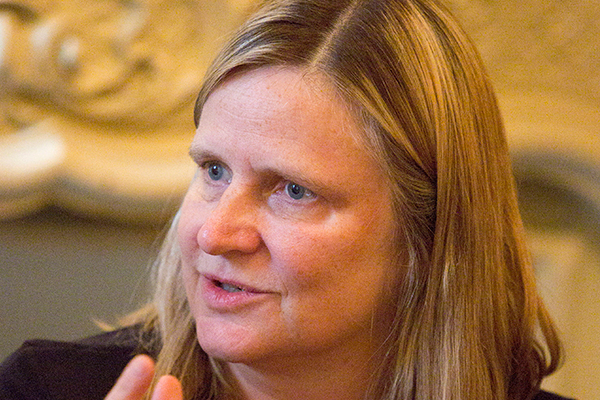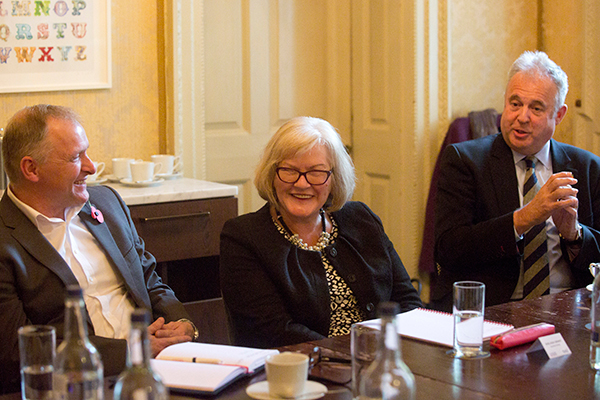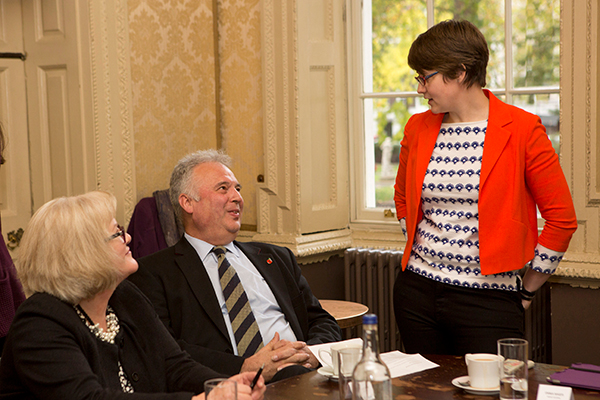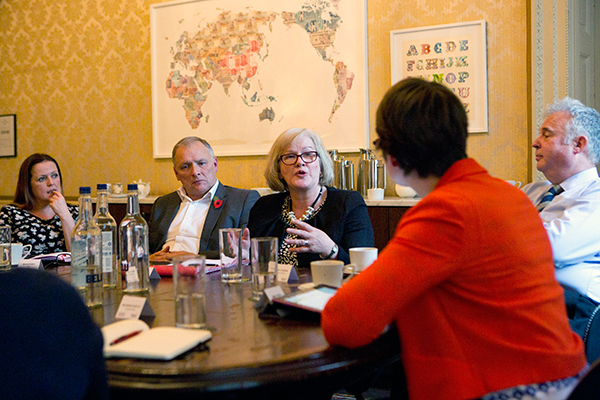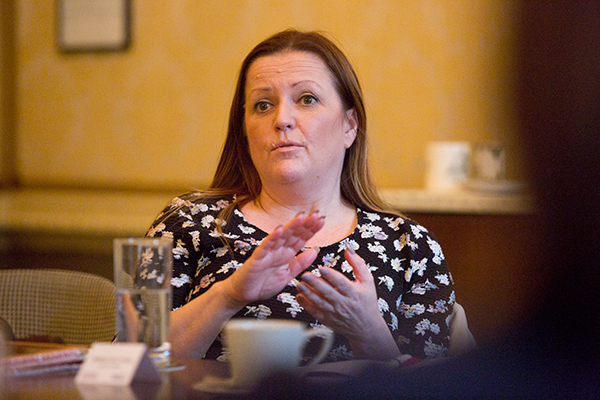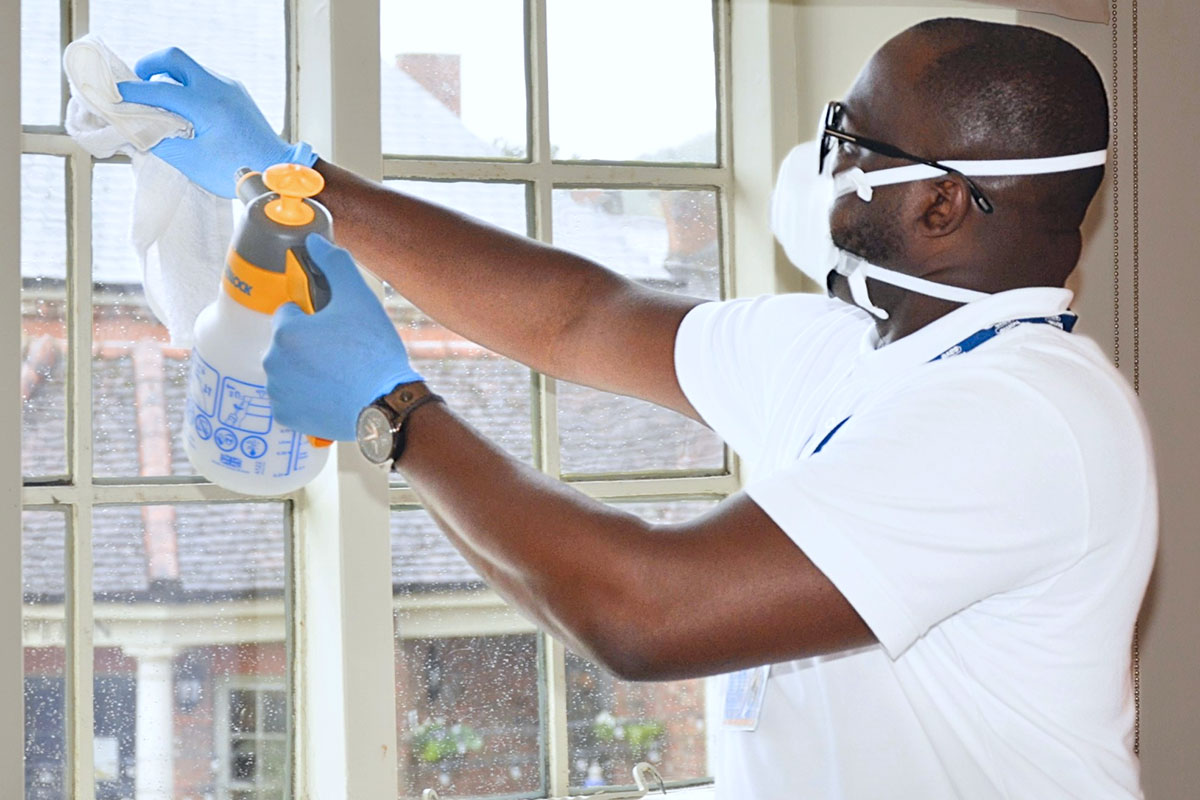Future plans
Inside Housing and Places for People bring together a panel of housing association chief executives to consider the future for the sector, and how it might be possible to adapt to it as well as shape it. Photography by Simon Brandon
In association with:

With its rococo plasterwork fireplace and original 19th century wall coverings, the Georgian Silk Room in the House of St Barnabas in Soho, London, evokes its eponymous era.
The eight chief executives gathered around its antique boardroom table are not here to look backwards, however; they have been brought together by Inside Housing and Places for People to make some predictions about the housing sector’s future.
After all, it is the job of business leaders to ensure their organisations are still relevant 30 years down the line. But the pace of change today is as dizzying as it is fast. Technology, demographics, the changing nature of employment and the increasing number of people for whom homeownership is becoming a distant dream: the list of factors that will shape the future for the sector’s organisations and its customers is long and daunting.
This meeting – convened to explore how business models will need to evolve for the future – is chaired by Inside Housing’s editor, Emma Maier, who begins by asking: what will things look like in 20 or 30 years’ time? How must the sector’s businesses change and adapt as we move forwards into that future, and how are organisations preparing themselves?
Sinéad Butters, chief executive of 8,500-home Aspire Group, brings up technology straight away. “The future of services is going to look very different,” she says. “Already we have salespeople in the US who are actually robots, and they are starting to pre-empt what the customer wants.”
Drive digital services
Embracing the improvements technology can bring to customer service is never going to be straightforward, however, as housing providers will need to balance this with the challenge of digital inclusion. As Ms Butters adds: “Given we can’t get people to log on and report a repair at the moment, there does seem to be a big gap.”
“We all talk about digital transformation, but one unintended consequence is isolation for people who are not digitally enabled,” agrees Mark Perry, chief executive of 30,000-home Vivid, formed earlier this year from the merger of First Wessex and Sentinel housing associations.
“There will be a time when everyone is [digitally] enabled and that will go away, but as we drive digital services we are acutely aware that some people just won’t get it. We need to be mindful that our customer base is going to need us to be sophisticated customer service businesses – one size won’t fit everybody.”
Technology will continue to play an ever-increasing part in the lives of older people, too – especially given our ageing population. Clare Tickell is chief executive of Hanover Housing, a specialist provider of housing for older people. She says a lot of her organisation’s thinking is around assistive technology and artificial intelligence as people become older and frailer.
“The state is contracting – there is less and less support. We are often the last person standing,” she says. “How can we anticipate? We’ve got gobby baby boomers coming in now, demanding far more than the people we currently house, and that’s not going to go away.”
Places for People is already looking at using robotics in care, according to group chief executive David Cowans. “We’ve got three studies going on, with real robots providing care services – one’s really good, the others are rubbish. But how much are you prepared to try things? It’s our job to stay ahead of the curve.”
Shelagh Grant, chief executive of cross-industry body The Housing Forum, believes technology can drive improvements to the quality of housing built in the future, too. “Our housing must be built to last,” she says. “What I’d like to see is a defect-free property built to the highest standards. If we can be open about the possibilities of technology, can we have a house that tells you if it’s ill or needs mending, so we can be more efficient and responsive?”
So what can housing providers do to prepare for an uncertain future? For Ms Butters, one obvious strategy would be for providers to work together more broadly and more productively.
“My concern is that as a sector we don’t collaborate,” she says. “We don’t have the sophisticated partnerships between each other that we should. I feel proud to be part of this sector, and yet somehow we seem to squabble over different models, what’s right and what isn’t.”
Bronwen Rapley, chief executive of Onward Homes, wonders whether the sector should be learning more by looking outside its own boundaries, too. “We do see ourselves as a bit special, but here are some things that other sectors do brilliantly,” she says. “Appointment systems, things like that – other people are doing them, they can’t be that hard, but we have to create a housing-specific one.”
The sector should look more at how it integrates with external organisations and people, she adds, not least in bringing outsiders into housing. “They bring a new way of thinking, and sometimes they bring a social heart as well. I’d like to see us much more open to that kind of fresh thinking in the future.”
The word ‘sophisticated’ becomes a theme of the wider discussion. Mr Perry says it is a characteristic he would like Vivid to embody more, especially when working with others within and outside the sector: “We need to be more sophisticated partners,” he says.
“In the future, understanding what local authorities, or indeed house builders or whoever need from us will be really important.”
Such partnerships will be fundamental to realising the attendees’ shared desire to keep building as many homes as possible into the future. But the development playing field is changing for housing associations. How can providers continue to build at scale in a future in which grant and a steadily rising housing market could both have disappeared?
“We are heavily dependent on cross-subsidy,” says Helen Evans, chief executive of 20,000-home Network Homes. “In the future I hope we will see a decreasing dependence on the current model – something more counter-cyclical that supports the economies in which we work outside the vagaries of the housing market.”
But what if the housing market collapses, asks Ms Butters – how much do developing associations rely on a growing market? And if the market does collapse, will housing providers have to start from a worse position because there is no grant to fall back on?
Less dependent on grant
Grant is a counter-cyclical instrument, but its time has passed – and it’s now time for housing providers to take the future into their own hands, argues Ms Tickell. “I can see no incentive to [bid] for grant any more… We have sucked up to whoever the government is in such a pusillanimous way, because our short-term business model says we will get money for that, rather than stepping back and understanding our long-term social purpose,” she says.
It is a change that is already taking place, according to Mr Perry. “We have become less dependent on grant,” he says. “We have to be mindful of those risks and make sure our business is robust. What are our risk mitigation procedures if the market takes a downturn?”
The other major factor coalescing inside developers’ crystal balls is the skills gap – and that’s even before we leave the European Union.
“We can build all these houses, but where will the people come from?” asks Gary Fulford, chief executive of 20,000-home WHG. “We have been running ambitious apprentice programmes for a few years now. We see that as a big part of our future.”
Land on which to develop will remain at a premium. The country therefore also needs to have a proper conversation about the green belt, argues Ms Grant, in a comment that draws a murmur of agreement from those seated around the table.
“I’d like to see a grown-up debate about the green belt, in which we talk about facts not emotions,” she says. “And it has to be a proper debate involving people who know about it.”
More generally, the sector has to keep its finger on the pulse, adds Mr Cowans. “We have to be aware of consumer trends and requirements, and we have to try and help people achieve their aspirations at price points they can manage. That’s easier said than done, but it’s easier than waiting for the government to tell us what to do.”
There are plenty of challenges to come and to be negotiated, but to conclude the discussion, Ms Maier asks the table what they see as the greatest opportunities going forward: “What makes you excited about the evolution of your organisations?”
For Ms Rapley of Onward Homes, passing on the mantle of leadership to a new cohort is going to be a positive step. “How can we take and use the experience we have to serve the next generation of leaders?” she asks. “They will be so much better equipped to deal with many of the challenges that are coming forward, but hopefully we have something to contribute as well.”
Ms Evans, meanwhile, believes there is excitement in the air. “We are at the tipping point with modernisation,” she says. “There is a pent-up energy in our organisation; we are just about to launch into a new way of working, and that is exciting. People all live in different ways; the way whole communities have been arranged could be changing. Tailored accommodation, short-term accommodation… understanding people better, what they want to do and how they want to live, could provide us with a lot of opportunities in the next two decades.”
For Mr Cowans, optimism is found in the sector’s confidence in its ability to shape its own future. “You can’t predict the future, but you can invent it,” he says. “We use hard data as much as we can, and we invent it – we must use more flexibility.”
That flexibility and responsiveness is going to be key, agrees Mr Fulford. Predictions are one thing but, as recent events have shown, events and change can come out of nowhere – and it’s how the sector reacts, finally, that will determine its success.
“Take smartphones,” says Mr Fulford. “Ten years ago I would never have thought there would be a device that could hold all my music and photos, and run my life,” he says. “So what’s the future going to be like? I haven’t got a bloody clue.
“For me, it’s about leading an organisation that is flexible enough to respond to what the future brings. The challenge is how we can become that organisation and keep ourselves relevant – and that is really exciting.”
Participants
Sinéad Butters
Chief executive, Aspire Group
David Cowans
Chief executive, Places for People
Helen Evans
Chief executive, Network Homes
Gary Fulford
Group chief executive, WHG
Shelagh Grant
Chief executive, The Housing Forum
Mark Perry
Chief executive, Vivid
Bronwen Rapley
Chief executive, Onward Homes
Clare Tickell
Chief executive, Hanover Housing
